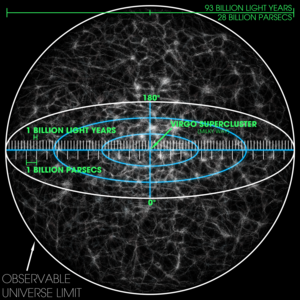Large scale structure of the universe

Visualization of the whole observable universe. The scale is such that the fine grains represent collections of large numbers of superclusters. The Virgo Supercluster – home of Milky Way – is marked at the center, but is too small to be seen.
|
|
| Diameter | 8.8×1026 m (28.5 Gpc or 93 Gly) |
|---|---|
| Volume | 4×1080 m3 |
| Mass (ordinary matter) | 1053 kg |
| Density | 9.9×10−30 g/cm3 (equivalent to 6 protons per cubic meter of space) |
| Age | 13.799±0.021 billion years |
| Average temperature | 2.72548 K |
| Contents |
Ordinary (baryonic) matter (4.9%) Dark matter (26.8%) Dark energy (68.3%) |
The observable universe is a spherical region of the Universe comprising all matter that can be observed from Earth at the present time, because electromagnetic radiation from these objects have had time to reach Earth since the beginning of the cosmological expansion. There are at least 2 trillion galaxies in the observable universe, containing more stars than all the grains of sand on planet Earth. Assuming the Universe is isotropic, the distance to the edge of the observable universe is roughly the same in every direction. That is, the observable universe is a spherical volume (a ball) centered on the observer. Every location in the Universe has its own observable universe, which may or may not overlap with the one centered on Earth.
The word observable used in this sense does not refer to the capability of modern technology to detect light or other information from an object, or whether there is anything to be detected. It refers to the physical limit created by the speed of light itself. Because no signals can travel faster than light, any object further away from us than light could travel in the age of the universe (estimated as of 2015[update] around 13.799±0.021 billion years) simply cannot be detected, as they have not reached us yet. In practice, the limit on observation is not 13.799 billion light-years for two reasons. The first reason is that space itself is expanding, so we can actually detect light from objects that were once close, but are now up to around 45.7 billion light years away (rather than up to 13.799 billion light years away as might be expected). The second reason is that before the recombination epoch, about 378,000 years after the Big Bang, the Universe was filled with a plasma that was opaque to light, and photons were quickly re-absorbed by other particles, so we cannot see objects from before that time using light or any other electromagnetic radiation. Gravitational waves and neutrino background would have been unaffected by this, and may be detectable from earlier times.
...
Wikipedia
